Advertisement
It’s been 25 years since inflatable life jackets were approved by the U.S. Coast Guard. Our BoatU.S. Foundation did a hands-on market review of today’s commonly available models. Here’s what we learned.
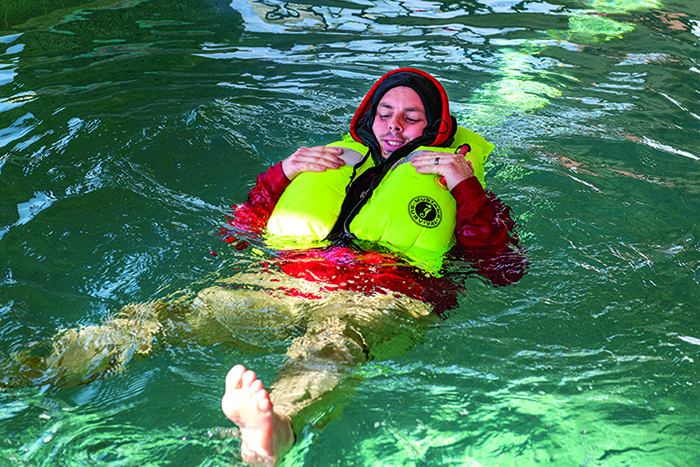
Capt. Brandon Jackson from TowBoatU.S. Baltimore floats in his Mustang MD3183.
If you were a boater in the late 20th century, you probably recall the life jacket options: the bulky Type I that made you feel like the Stay Puft Marshmallow Man, the screaming-orange horseshoe-style Type II that put you in a headlock, or the comparatively svelte Type III vest that most boaters preferred (if they wore one at all). Comfortable or not, these models were generally affordable, did their jobs, and saved lives – when they were worn, which only about 15% of recreational boaters did regularly, according to the U.S. Coast Guard Life Jacket Wear Rate Observation Study.
How to get more boaters to wear life jackets while underway has always been the “elephant in the boat” for our BoatU.S. Foundation for Boating Safety & Clean Water and other boating-safety organizations. In 1998, a new option became available to U.S. boaters – the inflatable life jacket. It was a turning point in boating safety: a wearable not much larger than suspenders (or a fanny pack); way less bulky than traditional options; and lightweight, more buoyant, and cooler to wear. These devices stayed nearly flat until you pulled a cord that activated a compact CO2 canister inside the jacket to inflate it. (Automatic and hydrostatic inflation came later.)
Bringing this trailblazing product to market in the United States didn’t happen overnight. It was the result of at least a decade of arduous work by a lot of people from all corners of the boating and product-testing industries. Ruth Wood, who was manager of the BoatU.S. Foundation at that time (later Foundation president and now a board member), was there from the start.
“It took a long time to pass some kind of standard with the Coast Guard,” she recalls.
At the time, inflatable life jackets were already in use in Europe (and by competitive sailors); Wood was advocating for using the European standards as the model for getting inflatables approved in the U.S. As for her role, she says her goal was ensuring the design of the jackets was comfortable for the boating public. “Otherwise, people weren’t going to wear them. You can design the hell out of it, but if no one will wear it. It sits on a shelf.”
Wood says there were three to four meetings each year, and manufacturers would bring their prototypes. “[The process] took so long that the standards kept changing, but it helped with the evolution of the inflatable life jackets.”
Life jacket statistics
- 81% Recreational boating-related fatalities in 2021 that resulted from falling overboard and drowning
- 400 Recreational boating-related drowning victims in 2021 alone who might still be alive today if they were wearing a life jacket
- 27% Average increase in overall life jacket wear between 1999 and 2021 (excluding PWCs) 42% Relative increase in number of adults observed wearing life jackets in open motorboats since 1999 (Most people who fell overboard and drowned were riding in open motorboats.)
- 37.1% Number of adults aboard sailboats observed wearing life jackets in 2021
- 173% Increase in life jacket-wearing adults aboard sailboats since 1999 — S.W. Statistics from the 2021 U.S. Coast Guard Recreational Boating
Statistics report and the 2021 National Observational Life Jacket Wear Study (uscgboating.org)
For several years during the 1990s, Wood commuted from BoatU.S. headquarters, then in Alexandria, Virginia, to Underwriter’s Laboratory (now UL Solutions) in Raleigh, North Carolina. “I went down every few weeks for testing in their labs and pools,” she says. “There was a lot of testing!” In addition to the Foundation, there were a cadre of stakeholders who also wanted to be part of bringing inflatables to market – the Coast Guard, life jacket manufacturers, boating safety groups. Wood says that was a major reason it took so long to get them approved. “UL liked to have consensus across the industry.”
The process was taking so much time, in fact, that the Foundation held a design contest to keep the idea of an inflatable life jacket alive and keep the public engaged. It was a success, Wood remembers. “It brought everybody out of the woodwork!”
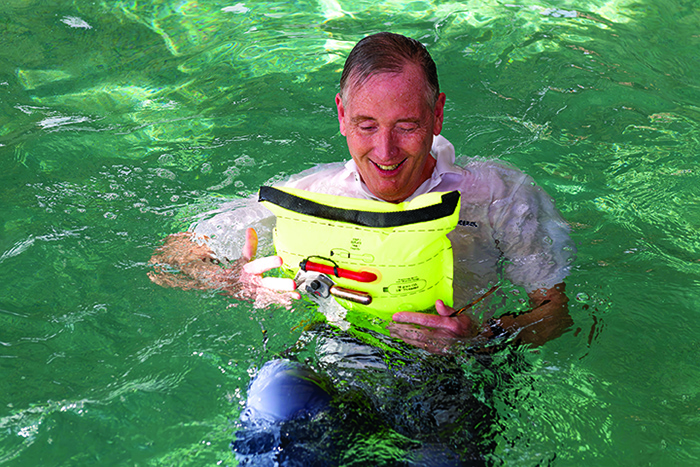
David is happy to see the flotation cushion on the Ultra-Lite belt pack after he surfaced feet-first.
But will that life jacket float?
Once the Sisyphean task of getting inflatables designed and approved was completed, it wasn’t always smooth sailing when it came to boaters embracing the new technology. First, there was the initial mistrust and skepticism – not unusual when a “disrupter” enters the market.
“This translated into jackets that were extremely durable and almost overbuilt,” explains current BoatU.S. Foundation president Chris Edmonston. Today’s jackets, in comparison, are also well-built, but they are lighter, made from more comfortable materials, and come in more styles and models than originally available.
Another barrier, Edmonston explains, was that years ago, if you saw someone wearing a life jacket on a perfect boating day, you might think something was wrong. “Now,” he says, “it’s just part of the gear, and no one seems to notice.”
A third issue is that there were (and are) many misconceptions about the legality of inflatables, especially as standards evolved. “The best rule of thumb is to look at the label for the jacket you have,” says Edmonston. “It tells you what the legal requirements are. Some jackets must be worn to meet carriage requirements; others don’t. It’s always on the label.” For more on this, see “9 Things to Know About Inflatables” below.
Finally, there was the cost factor. When inflatable life jackets came to market, they cost the equivalent of $200 or more in today’s money. Now there are models available for under $80, with many great options under $150.
So have inflatable life jackets changed boater habits over the last 25 years? Edmonston says he believes inflatables are the key reason that life jacket wearing has increased 27% since the U.S. Coast Guard’s National Observational Life Jacket Wear Study was first completed in 1999. (See “Life Jacket Statistics” above.)
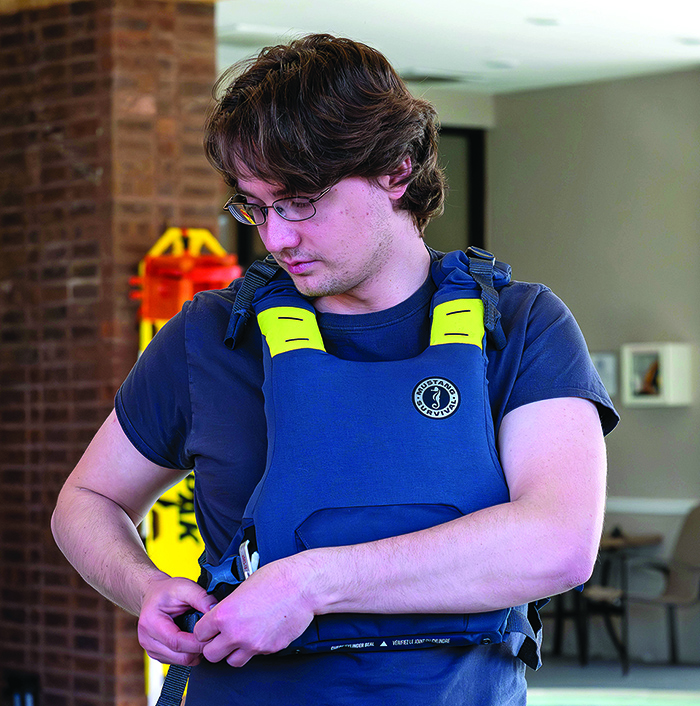
Devon does a dry fit of the Mustang Khimera.
Checking in
Periodically the BoatU.S. Foundation obtains and uses a current range of popular inflatable life jackets to track improvements, changes, new options, and trends. In February 2023, our staff and volunteers once again convened at a pool in Annapolis, Maryland. We purchased nearly two dozen inflatable life jackets, belt packs, and throwables, including U.S. Coast Guard-approved models from top manufacturers, plus some non-U.S.-approved models for comparison.
Volunteers included men and women ages 29 through 58 with a range of physical builds and boating and swimming experience. Each person did a dry fit of each wearable inflatable, including donning and adjusting straps, without input from the facilitators. The wearers and observers rated the ease of putting them on and adjusting, as well as gave feedback on comfort and ease of movement while the jackets were uninflated.
Testers then stepped into the deep end of the pool while wearing the life jacket. An observer with a stopwatch timed how long from the time the life jacket or belt pack submerged until it brought the wearer to the surface and fully inflated. Testers and observers offered feedback on the inflation process, swimability, ease of getting into the H.E.L.P. position, and the comfort of the inflated jacket in the water.
After the jackets dried, staff deflated, rearmed, and repacked them while taking notes on the process regarding ease and whether the inflatable repacked to the same condition it was when new. Refer to the comparison chart for info on each inflatable we reviewed, our notes, and what we learned.
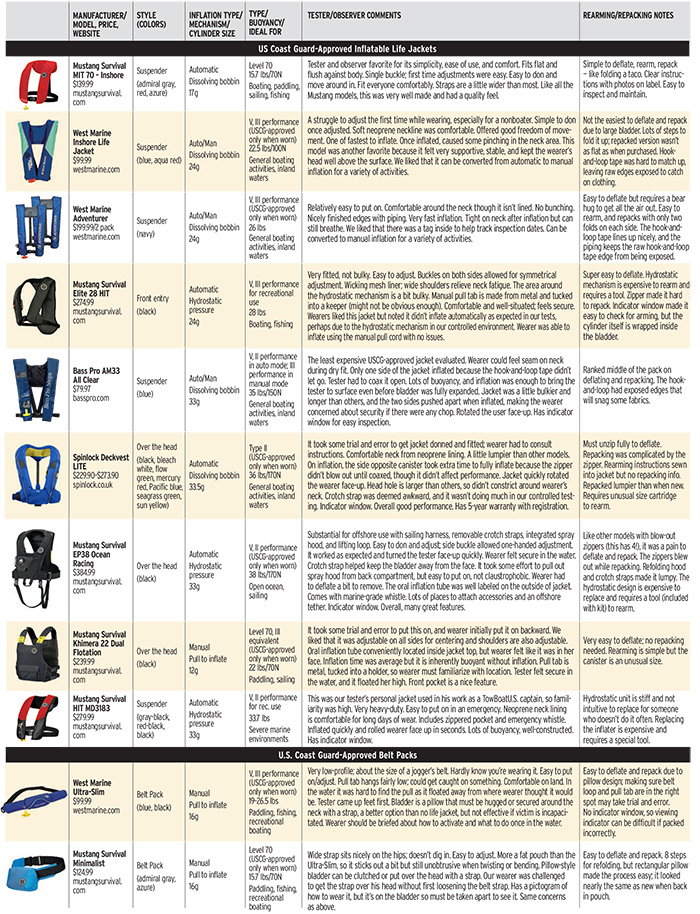
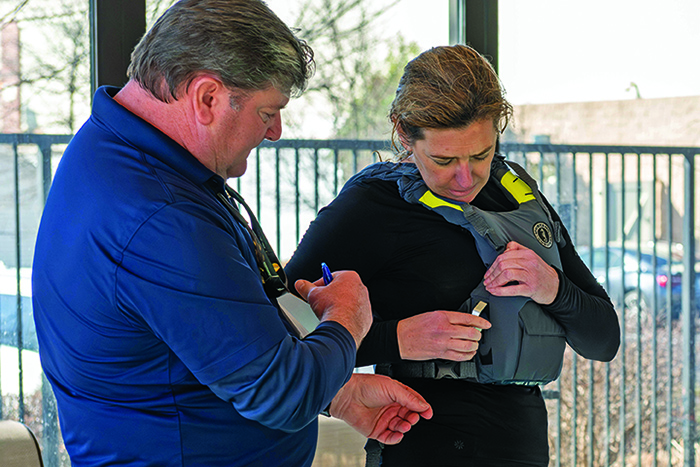
Ted shows Lynne where the pull tab is located before she steps into the pool.
9 things you need to know about inflatables
1. Inflatables are great, but only if worn.
2. Does it meet federal carriage standards?
Some U.S. Coast Guard-approved inflatable life jackets meet federal carriage requirements only if they’re being worn. Read the manual that comes with the jacket or the label on the jacket. You can wear nonapproved life jackets, but you must have other life jackets aboard that do meet carriage requirements.
3. Choose an appropriate life jacket.
Match the life jacket to the activity. Inflatables aren’t legal for watersports such as water skiing or using a PWC. The jacket label (and “Think Safe” booklet that comes with each Coast Guard-approved jacket) states the water conditions and activities for which that jacket was designed. In addition, “everyone needs to be honest with themselves as to their physical capabilities and swimming ability,” cautions Edmonston. “For some, an inflatable will never be the best option.”
4. The CO2 cartridge must be armed prior to wearing for the first time.
Most new jackets come with a yellow tab to remind you, but you may not notice it if you’re in a rush. (We made this mistake ourselves!)
5. Show your crew how to don the life jacket and adjust fit before you head out.
6. Know how the jacket will inflate.
Some inflate automatically when they contact water.
Some require the wearer to pull the cord manually. Belt packs require the wearer to put the inflated air bladder over their head or arms. All inflatables have a manual pull cord and oral inflation tube. Brief your crew members before you leave the dock.
7. Know how the life jacket will perform in the water.
Some are designed to flip the wearer face-up; others are not.
8. Inspect the life jacket before each use and at regular manufacturer-recommended intervals.
Ensure that the status indicator where the CO2 cartridge is installed is green. Every six months (or as recommended), perform a leak test by following the instructions that came with your life jacket. For automatic life jackets, check the expiration date on the dissolvable bobbin at the beginning of each season. Ensure they’re properly armed; free of rips, tears, and holes; all seams are securely sewn; and the fabric, straps, and hardware are still strong.
9. Keep extra arming kits and bobbins aboard.
Make sure you have kits for each brand of inflatable on board as they’re not universal in both style and buoyancy. — S.W.
